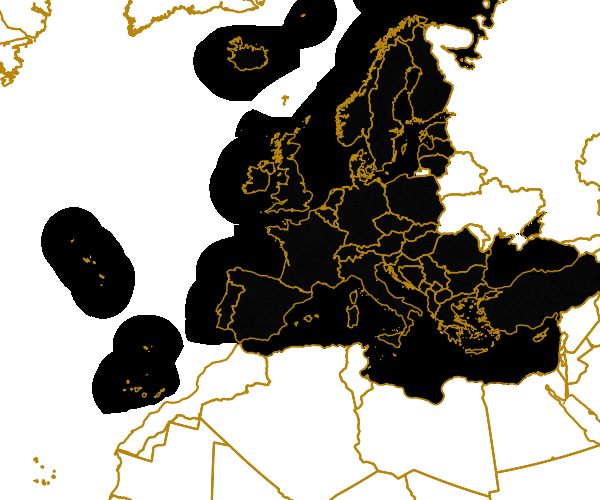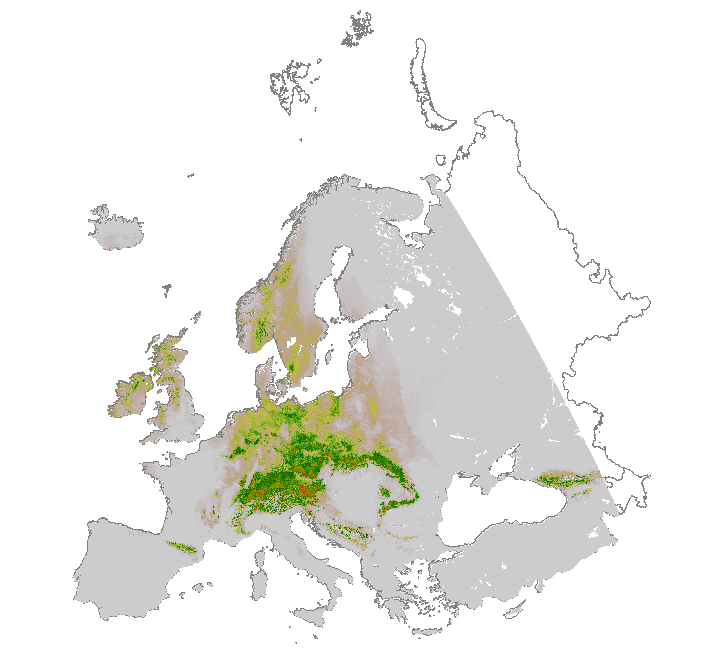2015
Type of resources
Available actions
Topics
INSPIRE themes
Keywords
Contact for the resource
Provided by
Years
Formats
Representation types
Update frequencies
status
Scale
Resolution
-

The data set combines the Corine based MAES (Mapping and Assessment of Ecosystems and their Services) ecosystem classes with the non-spatial EUNIS habitat classification (LEVEL 2) for a better biological characterization of ecosystems across Europe (EEA-39). As such it represents probabilities of EUNIS habitat presence for each MAES ecosystem type. The data set aims to combine spatially explicit land cover information with non-spatially referenced habitat information to improve our knowledge about ecosystems and their distribution across Europe. The work supports the MAES process, Target 2 Action 5 of the implementation of the EU Biodiversity Strategy to 2020, established to achieve the Aichi targets of the Convention of Biological Diversity (CBD). The objective of the ecosystem data set produced by EEA and its Topic Centre ETC/SIA was to improve the biological description of land cover based ecosystem types. It represents probabilities of EUNIS habitat presence in ecosystem types at European level. Since it is not based on spatial explicit mapping the spatial and thematic accuracy is not of same quality as delineated maps. The MAES ecosystem typology differentiates three levels: whereas the level 2 of the MAES proposal follows closely the EUNIS level 1, the third level of the MAES typology corresponds to the EUNIS level 2. This level will be the base for the mapping approach.
-

The data set combines the Corine based MAES (Mapping and Assessment of Ecosystems and their Services) ecosystem classes with the non-spatial EUNIS habitat classification for a better biological characterization of ecosystems across Europe (EEA-39). As such it represents probabilities of EUNIS habitat presence for each MAES ecosystem type. The data set aims to combine spatially explicit land cover information with non-spatially referenced habitat information to improve our knowledge about ecosystems and their distribution across Europe. The work supports the MAES process, Target 2 Action 5 of the implementation of the EU Biodiversity Strategy to 2020, established to achieve the Aichi targets of the Convention of Biological Diversity (CBD). The objective of the ecosystem data set produced by EEA and its Topic Centre ETC/SIA was to improve the biological description of land cover based ecosystem types. It represents probabilities of EUNIS habitat presence in ecosystem types at European level. Since it is not based on spatial explicit mapping the spatial and thematic accuracy is not of same quality as delineated maps. The MAES ecosystem typology differentiates three levels: whereas the level 2 of the MAES proposal follows closely the EUNIS level 1, the third level of the MAES typology corresponds to the EUNIS level 2. This level will be the base for the mapping approach.
-

The modelled suitability for the EUNIS habitat type is an indication of where conditions are favourable for the habitat type based on sample plot data (Braun-Blanquet database) and the Maxent software package. The modelled suitability map may be used as a proxy for the geographical distribution of the habitat type. Note however that it is not representing the actual distribution of the habitat type.
-

The verified habitat samples used are derived from the Braun-Blanquet database (http://www.sci.muni.cz/botany/vegsci/braun_blanquet.php?lang=en) which is a centralised database of vegetation plots and comprises copies of national and regional databases using a unified taxonomic reference database.
-

The concept of HNV farmland ties together biodiversity to the continuation of farming on certain types of land and the maintenance of specific farming systems. The general goal of the data set is to enhance the European map of HNV farmland that shows the estimated distribution and presence likelihood of HNV farmland across the whole European territory. The objective of the HNV farmland map produced by EEA is to estimate the presence likelihood of HNV farmland within Europe using existing Europe-wide datasets. The EEA points out that the existing datasets may have drawbacks for HNV farmland identification and recommends therefore that the map be used as a proxy for the distribution of HNV farmland at European level appropriate for assessment purposes only.
-

The modelled suitability for the EUNIS habitat type is an indication of where conditions are favourable for the habitat type based on sample plot data (Braun-Blanquet database) and the Maxent software package. The modelled suitability map may be used as a proxy for the geographical distribution of the habitat type. Note however that it is not representing the actual distribution of the habitat type.
-

The verified habitat samples used are derived from the Braun-Blanquet database (http://www.sci.muni.cz/botany/vegsci/braun_blanquet.php?lang=en) which is a centralised database of vegetation plots and comprises copies of national and regional databases using a unified taxonomic reference database.
-

The verified habitat samples used are derived from the Braun-Blanquet database (http://www.sci.muni.cz/botany/vegsci/braun_blanquet.php?lang=en) which is a centralised database of vegetation plots and comprises copies of national and regional databases using a unified taxonomic reference database.
-

The data set combines the Corine based MAES (Mapping and Assessment of Ecosystems and their Services) ecosystem classes with the non-spatial EUNIS habitat classification (LEVEL 1) for a better biological characterization of ecosystems across Europe (EEA-39). As such it represents probabilities of EUNIS habitat presence for each MAES ecosystem type. The data set aims to combine spatially explicit land cover information with non-spatially referenced habitat information to improve our knowledge about ecosystems and their distribution across Europe. The work supports the MAES process, Target 2 Action 5 of the implementation of the EU Biodiversity Strategy to 2020, established to achieve the Aichi targets of the Convention of Biological Diversity (CBD). The objective of the ecosystem data set produced by EEA and its Topic Centre ETC/SIA was to improve the biological description of land cover based ecosystem types. It represents probabilities of EUNIS habitat presence in ecosystem types at European level. Since it is not based on spatial explicit mapping the spatial and thematic accuracy is not of same quality as delineated maps. The MAES ecosystem typology differentiates three levels: whereas the level 2 of the MAES proposal follows closely the EUNIS level 1, the third level of the MAES typology corresponds to the EUNIS level 2. This level will be the base for the mapping approach.
-

The modelled suitability for the EUNIS habitat type is an indication of where conditions are favourable for the habitat type based on sample plot data (Braun-Blanquet database) and the Maxent software package. The modelled suitability map may be used as a proxy for the geographical distribution of the habitat type. Note however that it is not representing the actual distribution of the habitat type.
 RUC Geo-Data catalogue
RUC Geo-Data catalogue